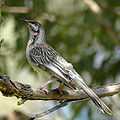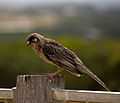Red Wattlebird
| Red Wattlebird | |
|---|---|
 | |
| Red Wattlebird feeding | |
| Conservation status | |
| Scientific classification | |
| Kingdom: | Animalia |
| Phylum: | Chordata |
| Class: | Aves |
| Order: | Passeriformes |
| Family: | Meliphagidae |
| Genus: | Anthochaera |
| Species: | A. carunculata |
| Binomial name | |
| Anthochaera carunculata (Shaw, 1790) | |
The Red Wattlebird (Anthochaera carunculata), also known as Barkingbird or Gillbird, is a honeyeater; a group of birds found mainly in Australia and New Guinea which have highly developed brush-tipped tongues adapted for nectar feeding. The tongue is flicked rapidly and repeatedly into a flower, the upper mandible then compressing any liquid out when the bill is closed.
Although honeyeaters look and behave very much like other nectar-feeding passerines around the world (such as the sunbirds and flowerpeckers), they are unrelated, and the similarities are the consequence of convergent evolution. The Red Wattlebird is a large (up to 35 cm) grey-brown honeyeater with red eyes, distinctive red wattles either side of the neck and white streaks on the chest and belly, which reveals a bright yellow patch towards the tail. Juveniles are generally less flamboyant, with less prominent wattles and browner eyes.[2]
The species is found in SE Queensland, New South Wales, Victoria, South Australia and southwest Western Australia in open forest, woodland, and near human habitation. The nest is formed from sticks and leaves lined with bark and hair, between 2 and 16 metres above ground, usually in the forked branches of a tree or shrub, in which two or three, pale brown-spotted pink eggs are normally laid.
In addition to nectar, it takes insects and other small creatures, usually by hawking, and also berries and other fruit.
This bird was first described by John White in his Journal of a Voyage to New South Wales (1790).[1]
Gallery
-

-

Feeding on Banksia sp. flower, Perth
-

-
Top view
-

-

Chick
-

Melbourne
-

Feeding
-

-

Showing Lemon-Yellow plumage
-

In a Banksia, Sydney, Australia.
References
- ↑ 1.0 1.1 BirdLife International (2012). "Anthochaera carunculata". IUCN Red List of Threatened Species. Version 2013.2. International Union for Conservation of Nature. Retrieved 26 November 2013.
- ↑ http://ozwildlife.awardspace.com/wildlifedetail.php?genus=Anthochaera&species=carunculata Entry at Oz Wildlife
External links
| Wikimedia Commons has media related to Anthochaera carunculata. |
| Wikispecies has information related to: Anthochaera carunculata |
- Red Wattlebird videos, photos and sounds on the Internet Bird Collection.
- Holotype of the Red Wattlebird Anthochaera carunculata in the collection of the Museum of New Zealand Te Papa Tongarewa

